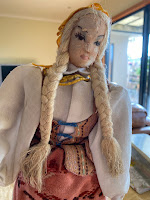
had presumed the doll was handed into the warehouse from family upon the death or cleanup of Statkeviciute’s household. On the base of the doll there was a red stamp with the words, Workshop for Lithuanian National Dolls, Laumė. Eng Arch Statkeviciutė, Lithuanian DP camp, Dilligen, Germany.
When accepting items into the Archives, knowing its provenance is very important. I had not seen that many artifacts from the DP camps and had certainly never heard of doll workshops. I knew it would be a great asset, as I would assume, very few, if any of dolls of this type had survived time. I wanted to see if I could find more information. The first assumption was a Statkevičiutė had come to Australia. I first consulted the National Archives but found no Statkevičiutė’s coming to Australia. Next was the German, Arlosen Archives that holds information about Displaced Persons. Here I found six Statkevičiutės, but which one? I viewed each record to see if it had information on the camps they lived in Germany. There was one match for Dilligen, Stefanija Statkevičiutė. I now had a full name and date of birth, 1 April 1915 in Vilnius. I still didn’t have a connection to Australia. Next a general search of her name and Dilligen, revealed that she was illustrated a children’s book while in the camps. I googled variations of her name and eureka an obituary showed up from Draugas and American Lithuanian newspaper, 1984.
Stefanija was born on 1 April 1915 in Vilnius. She first studied in Kudirkas Naumiestis, later for six years she studied at Vilkaviškis high school. After this her parents moved to Kaunas. The last two years she studied and graduated from St. Casimirs Girls' high school of the Congregation of Sisters in Kaunas. In 1933 in the fall, Stefanija enrolled in Vytautas the Great University Faculty of Technology, determined to be an engineer.
From Germany she migrated to Chicago where she worked as an Architect. The obituary tells the story of how Stefanija and her family took in a Jewish friend three-year-old girl. They changed her identity to avoid her being discovered. When the family fled, Lithuania, the child went also. The story ends well, she was reunited with her mother and went to live in Israel.
The death of engineer-architect Stefanija Statkevičiūtė-Traškienė was unexpected. She was preparing for a big trip to Australia to visit her sister Marytė, when she died.
She left behind her husband Alexander, and two daughters, a brother Jurgis and sister Marytė.
This gave me her married name, explained the letters Eng Arch, before her name on the bottom of the doll, Engineer, Architect. It also gave me a connection to Australia, through her sister Marytė. I felt sure this was how the doll came to end up here.
As there were no Statkevičiutė’s coming to Australia, I had to assume, Marytė came here married, but what was here married name? A search in Billion Graves, gave me a photograph of her grave. Marija Steponaitis, next to her husband Jonas. Buried in Hobart, Tasmania. I couldn’t find and children for Marija and Jonas for me to follow. I was going with the story that the doll was given to Marija, when she and her husband passed, their personal belonging went to auction. I now believed I knew who made the doll, and how it got here.
Well, you know what they say about, people who assume. I was still hoping to find a living relative, so I went back to Stefa’s family and started to draw up her family tree. Stefa had two children. I found an obituary for one in Draugas, that showed she passed away suddenly in Florida. Born in 1954, she married and became an anthropologist. No children were mentioned. I found a death notice for the other daughter, but no mention husband or children. I then found an obituary for Stefa’s mother, who confirmed the name of Marija’s surname in Tasmania.
The obituaries I found all mentioned brothers and uncles. I decided to look sideways into these families. Another detailed obituary, this time of Stefa’s husbands’ brother. This had a list of children, with their married names, which I looked into. Facebook is always a great place to search for living people, and here I came upon a match for one of them. So, I messaged her, explaining that I am looking for descendants of Stefa regarding a doll, I believed she made. Thankfully she responded quite quickly and filled me on the family. I had the correct family. She wrote that on Stefa’s death, her husband, Aleksandras remarried an Australian Lithuanian and moved to Sydney. She also mentioned she had more cousins in Australia. I now had several connections to Australia, so maybe my assumption of the doll coming here with Marija was incorrect. She remembers the doll in her aunt’s house, displayed in a cabinet and how Stefa was so proud of it. She believes, Stefa's husband brought it to Australia. The marriage ended after ten years and he returned to the US. For some reason, the doll was left behind and probably sold by the ex-wife.
I wanted to know if the Australian cousins, knew of the doll. Again, Facebook gave me a connection, but they had never seen or heard of the doll.
Through a journey around the world, made easy through the internet and archives, I could now add a story to the doll. Coincidentally, this week, I also received a box of 60 interviews on cassettes of interviews of Lithuanians, in Tasmania. Among them is an interview of Marija Steponaits. I can’t wait to listen to that.



